Wheelchair loading is very important for both active and passive wheelchair users who rely on wheelchair-accessible vehicles. These vehicles not only ensure barrier-free access, but also enable a smooth transfer between the wheelchair and the driver's seat. In this article, we highlight the importance of wheelchair loading and offer some advice for a smooth process.
Everything you need to know about the features and benefits of the Wheelchair loading for wheelchair-accessible cars (active and passive drivers) need to know.
Wheelchair vehicle conversion: Wheelchair loading is a crucial step for active drivers who want to optimize their everyday mobility. A well-designed system not only makes it easier to get in and out of the vehicle, but also promotes the user's independence and autonomy. This process ensures that the wheelchair is safely stowed in the car and that the driver can comfortably reach the driver's seat.
Here are some tips for smooth wheelchair loading:
Wheelchair loading is not only a practical aspect of mobility for active drivers, but also a key to promoting their independence. With the right equipment and a little practice, this process can be made efficient and safe, giving active drivers the freedom to flexibly organize their daily lives.
Wheelchair crane solutions offer excellent support for people with disabilities or senior citizens who want to load heavy aids such as wheelchairs or mobility scooters without physical exertion. With a wheelchair crane, wheelchairs and other aids can be loaded into the car quickly and easily without straining the back. In this article, you will learn everything you need to know about wheelchair cranes to find the right model for your vehicle.
The LADEBOY wheelchair loading aid is an extremely practical solution for wheelchair users with residual mobility, passengers with disabilities and accompanying persons who want to load the wheelchair into a vehicle. This versatile aid is suitable for both foldable wheelchairs with and without electric drive, such as e-fix and e-motion. The LADEBOY S wheelchair loading system enables the wheelchair to be loaded into the trunk and transported in an upright position. Especially in vehicles with high trunks, such as vans or minivans, the LADEBOY type S wheelchair loading aid offers the advantage of additional seats and more trunk space.
If the wheelchair is rigid or cannot be folded, but the interior of the vehicle is sufficiently high, the LADEBOY also allows the wheelchair to be loaded in an upright position. This is particularly possible in VAN or mini-VAN vehicles and requires a special holder for the wheelchair loading aid. The LADEBOY is able to safely lift walking aids weighing up to 20 kg (Ladeboy S Maxi up to 38 kg) into the vehicle. Rollators, foldable wheelchairs and foldable wheelchairs with electric add-on drives are ideal candidates for this flexible loading system.
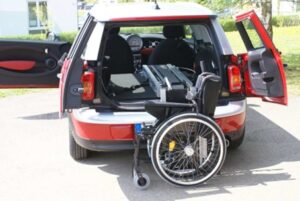
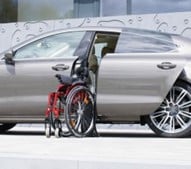
The Ladeboy S2 wheelchair loading system was specially developed for effortless loading of foldable wheelchairs. We have also developed a reinforced version - the Ladeboy S2 Maximum - to enable problem-free loading of wheelchairs with electric drive, such as e-fix and e-motion. In some vehicles, the LADEBOY S2 wheelchair loading aid can be optionally equipped with a swivel module, which enables additional seats (4-5 seats) depending on the vehicle type. In this case, a small part of the trunk is used for loading.
If you want to load the wheelchair unfolded, the LADEBOY S2 wheelchair loading system can be equipped with a special bracket that enables a rigid wheelchair to be accommodated. This means that the LADEBOY S2 offers maximum flexibility and adaptability to support different wheelchairs and vehicles.
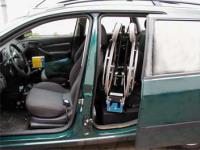
Advantages:
Scooters, electric scooters or wheelchairs are driven onto the platform and loaded into the vehicle with the wheelchair lift at the touch of a button. Without physical strength. Even with just one hand, the SCOOTERBOY wheelchair loading lift is easy and safe to operate. If the wheelchair is slightly higher, then VAN or van-type vehicles are the ideal combination with the SCOOTERBOY. This means that a wheelchair with a higher back section can also be loaded. The SCOOTERBOY wheelchair loading lift for loading a heavy wheelchair or mobility scooter in the trunk of your car (SUV, minivan and van). This is possible with all types of senior mobiles, senior vehicles or senior scooters and a vehicle that is large enough.
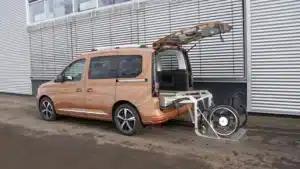
The SCOOTERBOY wheelchair loading lift for side loading of a heavy wheelchair or scooter in your car (minivan, van or transporter). This is possible with all types of senior mobility scooters, senior vehicles or senior scooters and a vehicle that has a standard sliding door. To keep the distance from the wheelchair to the driver's seat as short as possible, the SCOOTERBOY wheelchair lift can also be installed directly behind the driver's seat in vehicles with a side sliding door. Ideal for larger vans and transporters.
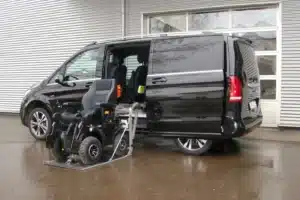
With just a simple push of a button on your dashboard, you can open the rear door, which has been converted into a parallel swing door, fully automatically. The EDAG system stops within reach, about 45° from the driver's seat. This process takes just 12 seconds.
You can then securely attach your folded wheelchair to the handle holder. No great effort is required, so that even people with limited hand and finger function can secure the wheelchair in seconds. At the touch of another button, the wheelchair moves to its final position behind the driver's seat and the door closes automatically. This loading process also only takes 12 seconds and can be interrupted at any time by releasing the switch.
Thanks to the integration of the wheelchair in the vehicle interior, it remains at a pleasant temperature even in winter. The compact and intelligent design makes it possible to have three to four seats (depending on the vehicle type). A stable wall safely separates the passengers from the wheelchair.
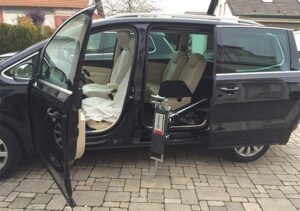
The Chair Topper is a system that can accommodate a foldable wheelchair in just 30 seconds. The weatherproof fiberglass box weighs 55 kg and can be attached to most vehicle models. The total weight, including the wheelchair, must not exceed 75 kg. The roof box raises the vehicle by 54 cm and is available for both the driver's and passenger's side.
Some features of the Chair Topper:
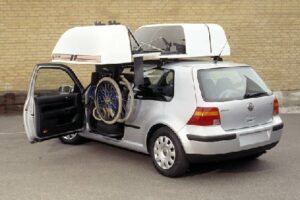
Century XT
Extra-long telescopic platform that offers space for standard-sized electric scooters and wheelchairs. The Century XT wheelchair lifts have a telescopic platform that can be extended to 142 cm, but still fit into a medium-sized transport vehicle. All movements of the wheelchair lifts for self-propelled wheelchairs are fully automatic and are controlled by the driver or an attendant using the standard hand control or the controls on the wheelchair lift.

Millennium
A robust and stable lifting platform that can be accessed from two sides. The Millennium range offers an exclusive double roll-off protection system, which is monitored by two separate systems, and all movements of the self-propelled wheelchair lifts are fully automatic and are controlled by the driver or an attendant using the standard hand control or the controls on the wheelchair lift.
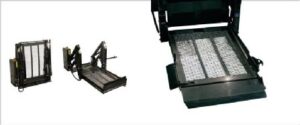
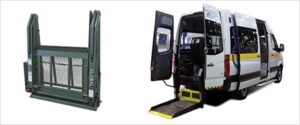
Swing-A-Way
Solves the problem of tight parking spaces with parallel entry and a unique swivel platform. By allowing the wheelchair user to roll onto the platform parallel to the vehicle, the Swing-A-Way offers unique possibilities for parking close to buildings or narrow sidewalks. The telescopic platform is extended to the length required for the wheelchair. All movements of the wheelchair lifts are fully automatic and are controlled by the driver or an attendant using the standard hand control or the controls on the lift.
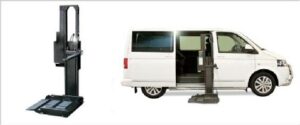
Vangater
Triple-split lift platform that can be accessed from two sides. The innovative, triple-split lift platform is stowed parallel to the vehicle door, saving space and allowing a clear view and unhindered entry and exit. The wheelchair lifts in the Vangater range are fully electric and are controlled by the driver or an attendant using the standard hand control or the controls on the lift.
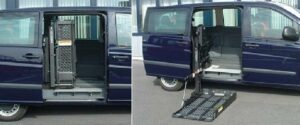
Vista
The lift platform for a clear view. When not in use, the lift platform is stowed underneath the vehicle windows, giving passengers and driver a clear view. All movements of the Vista range of self-propelled wheelchair lifts are fully automatic and are controlled by the driver or an attendant using the standard hand control or the controls on the lift.
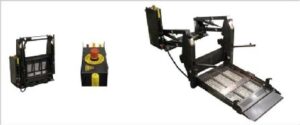
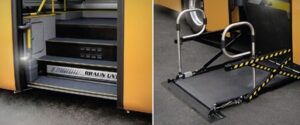
Vista Split
Stowed away to save space for a clear view and easy entry and exit. When not in use, this split lift platform is stowed parallel to the vehicle side walls so that it neither blocks the view nor gets in the way.All movements of the Vista Split range of self-propelled wheelchair lifts are fully automatic and are controlled by the driver or an attendant using the standard hand control or the controls on the lift.
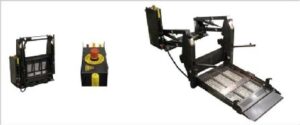
Linear lift
In conjunction with an automatic tailgate opener, this lift is suitable for both active and passive drivers. A remote control is available as an option. Thanks to its high load capacity, this lift can also be used with a power wheelchair, which can be used to drive right up to the steering wheel if necessary. Depending on the dimensions of the wheelchair and vehicle, it is possible to fit individual seats on the right-hand side so that passengers can be taken along.
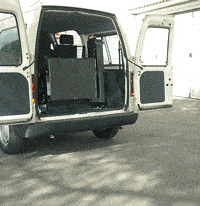
Underfloor cassette lift
The cassette lift installed under the vehicle floor does not take up any space in the interior. When not in use, it disappears completely under the vehicle. Equipped with a roll-over flap and a roll-off plate to protect the feet, it offers the necessary safety. Thanks to a recess on the right-hand side, it can also be accessed in relatively tight spaces, so that only a distance of around 1.3 m is required to get in and out. A remote control and an electronically operated sliding door can be installed on request.
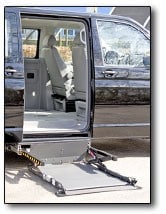
Swivel lift
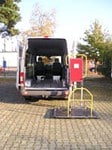
Wheelchair loading lift
The wheelchair lift requires very little effort from the user: simply drive onto the platform, secure the wheelchair or scooter, press the hand control button - done. This is the ideal wheelchair loading device for people with reduced muscle function. The vertical and horizontal speed can be programmed according to the user's needs. The lift has a loading capacity for wheelchairs or scooters weighing up to 158 kg. The lift is powered by the vehicle's own 12 V battery.
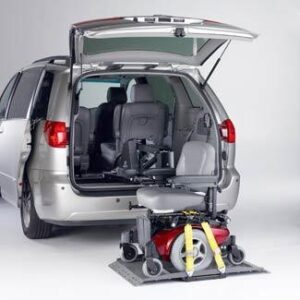
UVL
Free interior space for local buses. Model UVL855 is installed in the boarding area or at a specially designated point on the bus. The concealed installation saves space and guarantees maximum ground clearance.
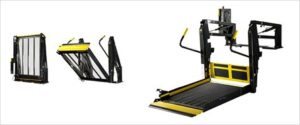
Cassette lift K90
The K90 cassette lift has been the most successful standard cassette lift for many years. The cassette of the fully automatic K90 is mounted laterally underneath the vehicle and does not impair access to or use of the passenger compartment. The super-flat design with a height of only 90 mm guarantees the greatest possible ground clearance. The closed stainless steel cassette ensures that the cassette lift is safely protected even in extreme weather conditions.
With a load capacity of 300 kg and a super-flat design, the cassette lift from AMF-Bruns is the ideal solution for free access to the passenger compartment. The large lifting platform of the cassette lift is also suitable for wide power wheelchairs. The design and construction offer optimum protection and the greatest possible safety for the transportation of disabled persons. A built-in buzzer warns the driver if the cassette lift has not been fully retracted into the cassette.
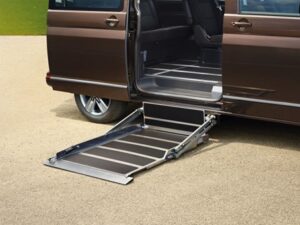
Cassette lift K90 Active
The K90 ACTIVE cassette lift can be conveniently operated from a distance of up to 20 m using an optional remote control. The safety door contact switch prevents operating errors during travel. The cassette of the fully automatic K90 ACTIVE is mounted on the side underneath the vehicle and does not impair access to or use of the passenger compartment. The super-flat design with a height of 90 mm guarantees the greatest possible ground clearance. The closed stainless steel cassette ensures that the cassette lift is safely protected even in extreme weather conditions.
With a load capacity of 200 kg and a super-flat design, the cassette lift from AMF-Bruns is the optimum solution for free access to the passenger compartment. The design and construction offer optimum protection and the greatest possible safety for the transportation of disabled persons. An automatic roll-over flap prevents feet from becoming trapped when the lift is raised. A powerful silent running carriage ensures smooth extension and retraction of the lifting platform. In addition, a built-in buzzer warns the driver if the cassette lift has not been fully retracted into the cassette.

BSL 350 swivel lift
The swivel lift is the classic in the product range, which can look back on over 30 years of success. As the swivel lift is operated directly from the sidewalk, it requires very little space behind the vehicle. This makes it possible to swivel in and out even in tight traffic conditions. The platform is raised and lowered away from the edge of the vehicle, which prevents the wheelchair user's feet from being crushed. The platform of the robust and durable swivel lift is raised using a hydraulic unit and lowered using its own weight. Used successfully thousands of times at home and abroad, 2 x 90° swivel version. The load capacity of the swivel lift is 350 kg with a usable lifting platform size of 1200 mm x 840 mm. All conversions with EMC testing in accordance with the EU directive. The wheelchair user is optimally secured by the two electrically secured roll-off safety flaps and the side guardrail. When folded, the swivel lift only requires an installation depth of around 30 cm in the passenger compartment.
The BSL 350 swivel lift is available for the following vehicles:
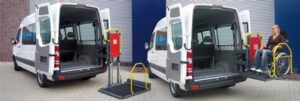
Joey lift
With the Joey-Lift, an unused scooter or power wheelchair weighing up to 159 kg can be lifted and loaded into a minivan or van at the touch of a button. The mobility aid is simply rolled onto the platform from any side and the straps for securing the mobility aid are attached. The mobility aid is then lifted at the touch of a button and loaded into the vehicle. Loading cranes make it possible to easily stow walking aids (e.g. rollators, wheelchairs and scooters) in a vehicle. This loading system can be used by accompanying persons, but also by wheelchair users who are still able to walk short distances without a walking aid. There are different models depending on the type of wheelchair and vehicle.
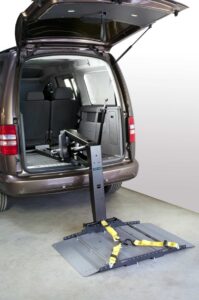
Carolift 40
The Carolift 40 is suitable for loading walking aids and non-electric wheelchairs weighing up to 40 kg. The slewing process is carried out manually. The loading crane is raised and lowered electrically and is controlled by a cable remote control.
With the articulated crane arm of the Carolift 40, the wheelchair can be maneuvered through narrow openings and past wide bumpers. In contrast to cranes with rigid arms, the wheelchair can be picked up from the ground next to the vehicle.
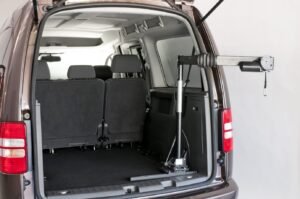
Loading crane
This loading crane can be used to lift, lower and swivel the walking aid electrically. The loading aid has a 20 cm extendable offset crane arm with which the walking aid can be picked up from the side of the vehicle. This loading crane is therefore ideally suited to transporting heavy power wheelchairs into a vehicle. The loading crane is suitable for up to 181 kg.
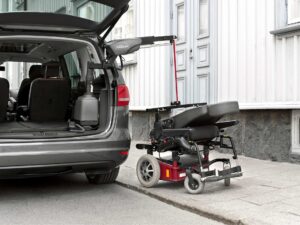
Robot 11
Another wheelchair loading system is the Robot 11, which automatically stows the wheelchair in the trunk. This loading system requires almost all of the space in the trunk, but does not affect any of the seats in the vehicle. This wheelchair loading system requires either the retrofitting of an automatic tailgate opening or the relocation of the switch of the existing tailgate opening into the driver's reach.
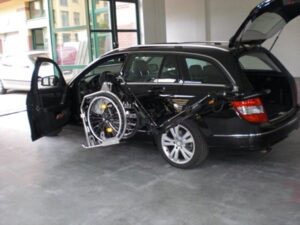
VA-4700
If you want to load your wheelchair unfolded and at the same time have a vehicle with sufficient interior height (if not, we can usually modify the backrest of the wheelchair so that it can be easily folded down or removed), this loading device is a good choice. The wheelchair prepared by us is 'clicked in' at two points and then loaded.
You can carry out the entire process with one hand while holding on to the vehicle with the other, for example. You can also use the sturdy lifting arm of the loading device as a "railing".
The standard version of the Buttler can lift wheelchairs with a maximum weight of 90 kg, the reinforced version can lift 120 kg.
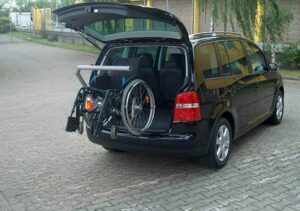
VA-20XX
Even with this wheelchair loading aid, you only need one hand for the entire process. In most cases, however, the wheelchair has to be folded before loading, but the rear loading boy is suitable for almost all types of car - including stepped hatchbacks. The 'Maximum' version of this loading device is suitable for wheelchairs weighing up to 50 kg.
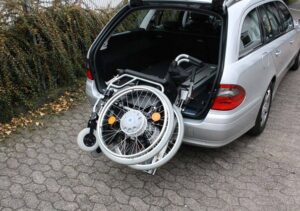
VA-4XXX and VA-5XXX
The choice of a loading device for the trunk of your vehicle should always take into account the size of the wheelchair, the trunk space and, above all, your physical condition.
With the "wheelchair cranes" VA-4000 (up to 35 kg) / VA-4500 (up to 90 kg) / VA-5000 (up to 150 kg) / VA-5500 (up to 200 kg), the lifting process is carried out electrically. The wheelchair, which we have prepared accordingly, is suspended from a rope or chain, so it usually needs to be 'guided' a little during the swiveling process. We recommend the use of the (optional) electric swivel device, especially for the VA-5000 and VA-5500 loading cranes.
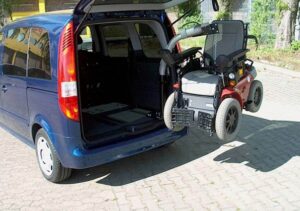
VA-35XX
The Smart Lifter LC / LP wheelchair loading aid is available in several versions: You can choose between a permissible lifting capacity of up to 80 / up to 100 / up to 125 / up to 150 or up to 200 kg. The wheelchair is not lifted by the rope, but with the help of the movable arm, which makes it easier to position the wheelchair in the trunk. The Smart Lifter LC / LP always swivels electrically.
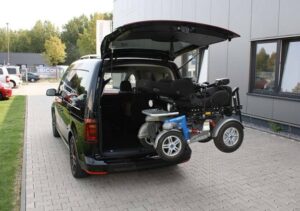
VP-5XXX
The cassette lift is suitable for both active and passive drivers. Thanks to its compact design, it is predestined for use in "smaller" vehicles such as minibuses or vans (e.g. VW T6, Mercedes Vito/V-Class etc.). The platform of the lift extends sideways and is then raised to the height of the vehicle floor, after which the user can lower it downwards. When retracted, a roll-off flap protects the structure from dirt and moisture. In cases where the ground clearance is not sufficient despite the use of a cassette lift in flat design (one of the possible variants of the lift), we have a chassis extension available for you.
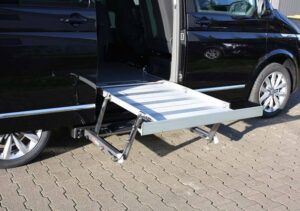
VP-5500
The K90 Active cassette lift differs from the 'normal' cassette lift primarily due to its significantly smaller platform (approx. 800 x 680 mm). In addition, the platform is accessed from the side - parallel to the vehicle - which significantly reduces the space required during use. This solution is particularly suitable for active users with compact wheelchairs.
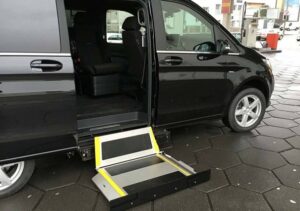
VP-9200
The rear cassette lift is usually used in cases where the installation of a lift in the vehicle interior is not desired. This product is installed 'underfloor' and therefore does not take up any space inside the vehicle.
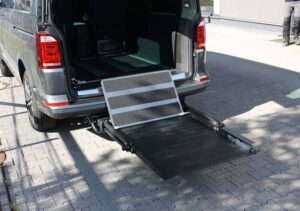
VP-7000
The two-arm lift is a lifting device for transporting wheelchair users. The platform folds out to the rear and remains horizontal at the level of the vehicle floor. The user can then lower it downwards. Thanks to its robust, two-armed design, it can also be used for heavy loads and the 'rough and tumble' of everyday life in disabled driving services.
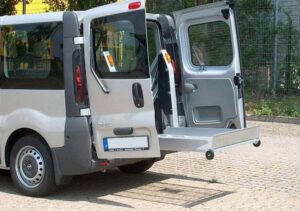
VP-7500
The two-arm lift with grit platform makes it easier to get into the vehicle even without lowering the platform. When retracted, the platform 'opens' inwards, which also improves visibility to the rear, especially when installed at the rear.
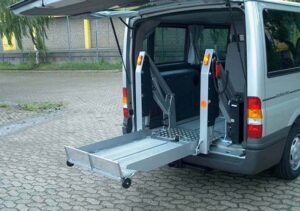
VP-7510
With this lift, the (split) platform is automatically folded up when it is raised to the vertical position. As a result, it has a lower installation height with a platform length comparable to the VP-7000. This feature enables installation in vehicles that do not offer sufficient interior height for the use of a lift with a rigid platform. This product also significantly improves visibility to the rear.
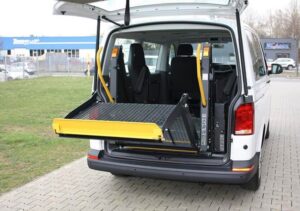
Reasons for using a wheelchair crane in the car
The use of a wheelchair crane offers numerous advantages for people who regularly have to transport wheelchairs or mobility scooters. It allows heavy aids to be stowed in the trunk without back strain, is easy to operate and is suitable for many types of vehicle. With various systems that can lift between 40 and 180 kilograms, there is the right model for every need.
Choosing the right wheelchair crane system for your car
Choosing the right wheelchair crane system is an important decision that depends on various factors. To ensure that you find a system that meets your requirements, you should consider the following selection criteria:
Weight of the wheelchair: The weight of your wheelchair is a decisive factor, as different crane systems have different weight limits. Make sure that the crane system you choose can easily handle the weight of your wheelchair.
Trunk size: The size of your vehicle trunk also plays an important role in choosing the right wheelchair crane system. Measure the available space in your trunk to make sure that the chosen system will fit in there.
Individual requirements: Each person has different requirements that should be considered when choosing a crane system. For example, in addition to assistance with lifting, some people also need help with swiveling the wheelchair into the vehicle, which some systems also offer.
Type of crane system: As mentioned above, there are different types of wheelchair cranes, such as manual, electric and permanently installed systems. Consider which system is best suited to your situation and make your decision based on this.
Budget: Wheelchair crane systems can have different prices depending on factors such as brand, model and functionality. Consider how much you are willing to spend and look for a system that fits your budget.
Popular wheelchair crane models for the trunk: Carolift 40 and Carolift 90 in comparison
The Carolift 40 and Carolift 90 from BraunAbility are two popular wheelchair crane models that can make life easier for people with wheelchairs or other aids. Both models offer different functions and are suitable for different vehicle types and usage scenarios. Here are the main differences, advantages and disadvantages of the two models:
Carolift 40: Flexible and versatile
Carolift 90: Powerful and robust
When deciding between the Carolift 40 and the Carolift 90, you should consider your individual requirements. The Carolift 40 is more flexible and versatile, while the Carolift 90 offers more stability and a higher load capacity. Both models have their own advantages and disadvantages, and it is important to choose the model that best suits your situation.
Safety and maintenance: important aspects to consider
Safety should be a top priority when choosing a wheelchair crane. It is important that the crane is both electromagnetically compatible (EMC) and crash-tested to ensure that it complies with current safety standards and does not pose any additional risks in the event of an accident. Here are some criteria you should look out for to ensure safety when using a wheelchair crane:
EMC testing: Electromagnetic compatibility (EMC) is an essential aspect of ensuring that the crane works properly in an electromagnetic environment without affecting other electronic devices or systems in the vehicle.
Crash test certification: A crash test-certified wheelchair crane gives you the assurance that it has a certain stability and strength in the event of an accident. This minimizes the risk of injury to the occupants of the vehicle.
Quality materials and construction: Make sure that the wheelchair crane is made of high-quality materials and has a solid construction. This ensures a long service life and safe operation of the crane.
Proper installation: Proper installation of the wheelchair crane is crucial to ensure that it is safe and stable during travel. Have the installation carried out by qualified specialist companies to avoid potential problems.
Regular maintenance: Regular maintenance and inspection of the wheelchair crane is necessary to ensure that it is always in perfect condition. Check the connecting elements, cables and joints regularly to ensure the safety of all occupants.
Used wheelchair cranes: What you should consider when buying
Buying a used wheelchair crane can be a cost-effective alternative to purchasing a new model. However, there are some important factors you should consider when looking for a used wheelchair crane to ensure you get a safe and reliable system.
Origin and condition: Make sure that the used wheelchair crane comes from a reputable seller and that the condition of the device is appropriate. Ask for maintenance records and any repairs to ensure that the device has been well looked after.
Compatibility: Make sure that the used wheelchair crane is compatible with your vehicle and mobility aid. Find out about the load capacity, mounting requirements and dimensions of the crane to make sure it is suitable for your needs.
Prices and costs for wheelchair cranes for cars
The cost of a wheelchair crane can vary depending on the type and equipment of the crane. In general, prices for a new wheelchair crane range between €2,500 and €7,000. A simpler manual wheelchair crane is usually cheaper, while an electrically operated crane with additional functions and a higher load capacity can cost more.
When buying a used wheelchair crane, it is important to consider the condition and quality of the crane, as this can greatly affect the cost afterwards. A used crane can be significantly cheaper than a new one, but keep in mind that there may be additional costs for maintenance and repairs.
It is advisable to obtain quotes from various specialist companies and compare both new and used models. When buying a used crane, also take into account the costs of transporting and installing the crane as well as any training required to operate the crane safely and effectively.
Conclusion: Finding the best wheelchair crane solution for your car
A wheelchair crane offers enormous relief for people who are dependent on mobility aids such as wheelchairs or electric scooters. Thanks to the various models and adaptation options, there is a suitable solution for almost every vehicle. The simple operation and back-friendly transportation of heavy aids enable greater independence and flexibility in everyday life. Find out more about the various wheelchair crane systems and their advantages and disadvantages in order to find the best solution for your individual needs.
High-roof estates are often preferred for wheelchair-accessible vehicles, as they have sufficient interior height. This makes it possible for a person in a wheelchair to either drive into the vehicle independently or be transported in by others. When choosing a suitable vehicle model for a rear cut-out conversion, you should consider the size, budget and requirements of the people to be transported. Here are some examples of vehicle models that are commonly used for rear cut-out conversions:
Volkswagen Caddy: The VW Caddy is a popular model for rear cut-out conversions due to its spacious interior design and the available long wheelbase version, which offers additional flexibility in the arrangement of seats and wheelchair positions.
Renault Kangoo: The Renault Kangoo is another common vehicle model for wheelchair accessible conversions, offering a good combination of space and cost efficiency. Its compact size and maneuverability make it an excellent choice for urban transport.
Mercedes-Benz V-Class: The Mercedes-Benz V-Class is a good option for driving services or families looking for a high-quality and spacious vehicle. Its robust construction and extensive safety features provide a reliable basis for rear cut-out conversions.
Ford Tourneo Custom: The Ford Tourneo Custom is another vehicle model that is well suited for rear cut-out conversions. With its flexible interior design and various available wheelbase options, specialist companies can install a wide range of ramp solutions for vehicle conversions.
Fiat Doblo: The Fiat Doblo is a cost-effective option for wheelchair accessible vehicles. Its compact size and spacious interior make it a suitable choice for urban traffic and smaller transportation requirements.
Choosing the right vehicle model depends on your individual requirements and budget. To make the best decision for your rear cut-out conversion, you should compare different models and choose the option best suited to your requirements.
Types of wheelchair ramps and wheelchair restraint systems
Wheelchair ramps are an essential component of wheelchair-accessible vehicles and enable easy access for people in wheelchairs. There are different types of wheelchair ramps that can be selected depending on requirements and vehicle type. Here are the most common types of ramps and their features:
Mechanically folding wheelchair ramp: This ramp must be opened and closed manually. It is a cost-effective option and is suitable for people who do not require electrical assistance. Mechanically folding ramps are generally light and easy to use, but require physical effort to fold and unfold.
Inward-folding wheelchair ramp (also known as a "cab ramp"): This ramp can be folded completely inwards, creating a flat trunk surface when folded down. This option is practical if wheelchair transportation is not required, as the space can be used for other purposes. Ramps that fold inwards are particularly suitable for vehicles that are to be used both for transporting people in wheelchairs and for everyday use.
Electric folding wheelchair ramp: This ramp can be opened and closed electrically by pressing a switch. It offers more comfort and ease of use, especially for people with limited strength. Electrically folding ramps are generally more expensive than mechanical ramps, but reduce the physical effort required to fold and unfold them. Electrically folding ramps are often installed when a person in a wheelchair wants to drive their vehicle themselves and therefore needs to get into the vehicle independently.
In addition to wheelchair ramps, wheelchair restraint systems also play an important role in the safety and user-friendliness of wheelchair-accessible vehicles. Here are some common systems and their functions:
Retractors / belt system: The combination of retractors and hook or loop belts is used to securely fasten the wheelchair to the vehicle floor. These systems are easy to operate and provide reliable securing of the wheelchair during the journey.
Diagonal shoulder belt / lap belt: These belts are essential for securing the person sitting in the wheelchair. They ensure that the person in the wheelchair remains safely and comfortably in the wheelchair during the journey.
Docking station: This alternative securing system can be installed instead of the retractors. The docking station makes it quick and easy to secure the wheelchair in the vehicle by simply snapping the wheelchair into the station.
Folding head and back support: These supports provide additional protection for the person sitting in the wheelchair. They provide additional comfort and stability during the journey, especially during abrupt braking maneuvers or uneven road conditions. Folding head and back supports are adjustable and can be adapted to the individual requirements of each person to ensure optimum fit and support.
Electric pull-in winch: An electric pull-in winch offers a convenient way of pulling the wheelchair into the vehicle without much effort. It is particularly helpful for people with limited strength (e.g. older relatives) and reduces the physical strain when loading the wheelchair. The winch is operated with a remote control so that the wheelchair can be pulled into the vehicle effortlessly.
When selecting wheelchair ramps and wheelchair restraint systems, it is important to consider the requirements of the person in the wheelchair as well as the vehicle configuration. Careful consideration of the various options and functions can help to find the best solution in terms of safety and user-friendliness.
Flexibility and comfort in the interior thanks to the right fit
Wheelchair-accessible vehicles offer flexible seating options and interior adaptations to maximize comfort and usability for all occupants. These include fold-down rows of seats, swivel-folding seats and generous cargo areas. On models with a long wheelbase, additional seats can be integrated for group transportation. Common adaptations and seating options include
Retention of the middle row of seats: In many vehicles with rear cut-out conversions, the middle row of seats is retained. If a person in a wheelchair needs to be transported, this row of seats can be simply and easily folded forward. This offers additional flexibility, especially if the vehicle is to be used without using the wheelchair space.
Swivel-folding seats: Swivel-folding seats are a practical solution for increasing the number of seats in a vehicle with a rear cut-out. They are particularly useful for group transportation or when additional seats are required for other passengers. When not in use, these seats can simply be folded up and moved out of the way to make room for the wheelchair or bulky luggage.
Customizable interior design: The interior design of vehicles with a rear cut-out can be adapted to the individual requirements of people. This can include the arrangement of the seats, the positioning of wheelchair restraint systems or the installation of additional safety and comfort functions.
The various seating options and interior adaptations help to ensure that wheelchair-accessible vehicles can be used flexibly and comfortably. Careful consideration of the various options and functions can help to find the best solution for individual requirements.
Costs for a rear cut-out: price factors and budget planning
The cost of a rear cut-out with wheelchair ramp can vary depending on the vehicle model, the type of conversion and the equipment options selected. As a rule, the prices for a rear cut-out conversion are between 8,000 and 10,000 euros. The costs depend on various factors, such as
Vehicle type and size: The larger the vehicle and the more complex the bodywork (e.g. laying cables and the tank), the higher the costs.
Selection of wheelchair ramp and wheelchair restraint system: High-quality and technically more sophisticated systems are generally more expensive. For example, the cost of an inward-folding or electrically folding ramp is usually higher than the cost of a simple, mechanically folding ramp.
Adaptation of the interior: The costs also vary depending on the extent of the desired adaptations, e.g. seat variants, interior trim and additional equipment options such as an illuminated wheelchair space.
Regional differences: Prices can vary depending on where and with which provider the conversion is carried out.
It is advisable to obtain quotes from various specialist companies for vehicle conversions and compare them with each other. You should also find out about possible subsidies and financial support options in order to reduce the costs of a rear cut-out conversion.
Maintenance, safety and approval: what you need to know
Regular maintenance and safety checks are important for wheelchair-accessible vehicles to ensure safe operation. Make sure that the systems and conversions used are DIN and ISO approved. Find out about the legal requirements and approval regulations for wheelchair-accessible vehicles.
Maintenance and inspection: Regular maintenance and inspections are crucial to ensure the safety and reliability of a wheelchair-accessible vehicle. This includes checking access ramps, wheelchair restraint systems and seat belts. It is important to follow the recommendations of the vehicle manufacturer and the conversion company regarding maintenance intervals and inspections.
Safety standards: Wheelchair-accessible vehicles should comply with the applicable safety standards. These include DIN and ISO tests for passenger and wheelchair restraint systems. Make sure that the vehicle and its adaptations have been tested and certified by recognized organizations to ensure passenger safety.
Registration and insurance: Depending on local regulations and laws, the registration and insurance of a wheelchair accessible vehicle may have special requirements. It is important to check with the relevant registration office and insurance company to ensure that the vehicle is properly registered and insured. This is especially true if you want to rent a car with a rear cut-out.
Training for drivers and caregivers is essential to ensure the safety of people with disabilities and other occupants. People who drive or operate a vehicle with a rear cut-out should be familiar with the handling of the vehicle and its equipment. This training can cover aspects such as the correct use of access ramps, wheelchair restraint systems and other safety features.
Taking these important training courses into account as part of the maintenance, safety and approval of a wheelchair-accessible vehicle helps to ensure that people with disabilities, their relatives and also transport services can travel safely and comfortably.
Vehicles with rear cut-out for self-propelled vehicles
A rear cut-out can also be of interest to people in wheelchairs who wish to drive themselves. This makes it possible to get directly into the vehicle with the wheelchair, securely fasten the wheelchair and steer the vehicle independently.
First, an electrically operated ramp at the rear of the vehicle provides access for the wheelchair. In this case, the person with a road-approved power wheelchair drives over the ramp and enters the vehicle directly. A flat floor surface behind the steering wheel ensures that the wheelchair can be easily navigated up to the steering mechanism.
To ensure that the wheelchair is properly secured during the journey, the vehicle has a docking station. As soon as the wheelchair is in the desired position behind the steering wheel, it locks into the docking station and is thus properly secured for the journey.
Additional driving aids can be integrated for optimum adaptation to individual requirements. These include, for example, hand throttle and hand brake devices, steering aids, gearshift and operating aids as well as voice control systems. These adaptations enable the person in the wheelchair to drive the vehicle independently and safely.
The combination of easy access, secure wheelchair attachment and other driving aids such as hand controls and rotary knobs enables people with disabilities to participate independently and comfortably in road traffic.
Conclusion
Individual rear cut-out solutions for wheelchair-accessible vehicles offer people with disabilities, their relatives and also transport services an excellent opportunity to make everyday life more flexible. By selecting the right vehicle model, ramp system and safety equipment, the transportation of people in wheelchairs can be made safe, comfortable and flexible. When adapting vehicles, make sure you comply with the applicable standards and legal requirements to ensure the best possible quality and safety.
The exact procedure depends on the vehicle model and the specific adaptations. Loading is usually carried out using ramps or other specialized loading systems.
There are ramps, electric loading systems, swivel systems, lift systems and other specialized systems that can be selected depending on the vehicle type and individual requirements.
Yes, many active drivers can load their wheelchair independently with training and suitable loading systems.
Vehicles with a low floor, special access ramps and electric loading systems make wheelchair loading much easier.
The duration depends on the user's experience, the type of loading system and individual customization. With practice, the process can be made more efficient. There are systems that make loading take less than a minute.
Compatibility depends on the specific system and vehicle models. However, some systems are flexibly adaptable.
Yes, but additional precautions should be taken in slippery conditions to ensure safety.
Yes, in many cases, specialized loading systems can be retrofitted in vehicles.
You are welcome to visit our guide.
Individual characteristics such as size, weight and design of the wheelchair influence the selection and adaptation of the loading system. Foldable wheelchairs are the first choice for most systems, while other systems only allow maximum weights of 75 kg.
Integrated safety belts and devices ensure that the wheelchair is securely fastened during the journey.

By loading the video, you accept YouTube's privacy policy.
Learn more

By loading the video, you accept YouTube's privacy policy.
Learn more